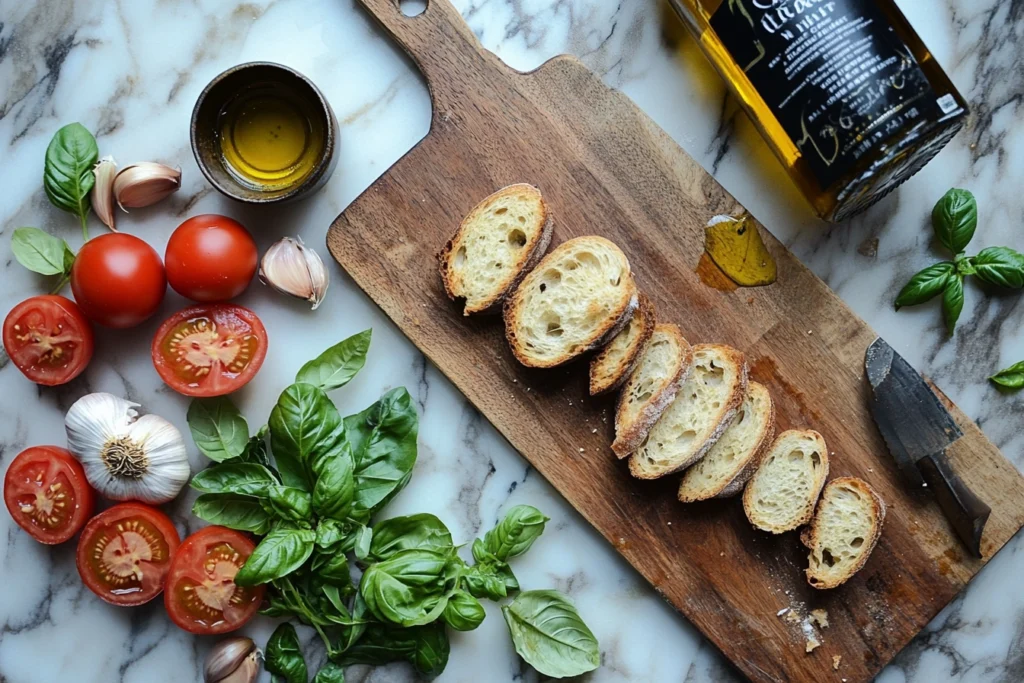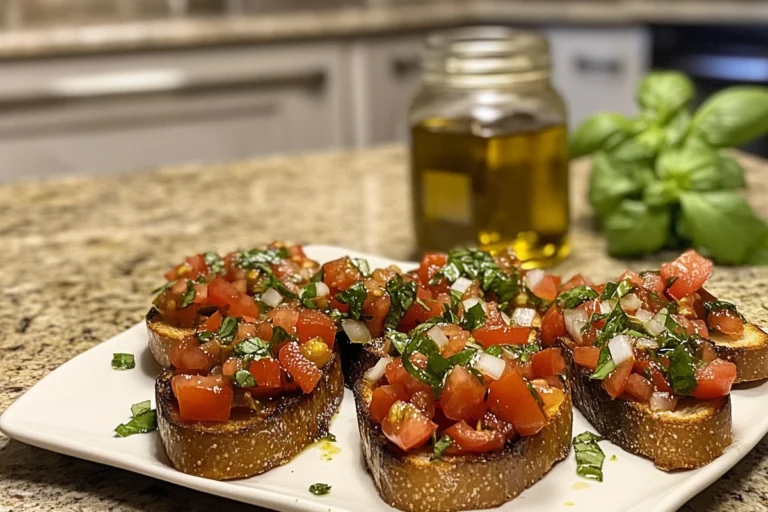Bruschetta—just the sound of it feels a little fancy, right? But don’t let that fool you! At its core, it’s one of the simplest and most delicious Italian appetizers out there. This classic dish, loved by foodies around the world, started as a humble way to use up stale bread and highlight fresh ingredients. But today, we’re diving into the heart of it: what is the traditional topping for bruschetta? Spoiler alert—it’s all about tomatoes, olive oil, garlic, and a sprinkle of love.
Introduction to Bruschetta: A Timeless Italian Starter
If you’ve ever been to an Italian trattoria or hosted a casual dinner party, you’ve likely encountered bruschetta. But do you know its story? This simple appetizer hails from Italy, where it’s pronounced “broo-SKET-tah” (not “broo-SHET-tah,” by the way). Traditionally, it’s served as an antipasto, or appetizer, meant to kick off a meal in style.
Why is bruschetta so popular? Honestly, it’s the perfect combination of crispy bread and fresh toppings. It’s like the little black dress of appetizers—always classy, always satisfying.
Table of contents
- Introduction to Bruschetta: A Timeless Italian Starter
- What Defines a Traditional Bruschetta?
- The Traditional Topping for Bruschetta: Tomatoes and Beyond
- Common Variations of Bruschetta Toppings
- Preparing the Perfect Traditional Topping Bruschetta at Home
- Troubleshooting Common Bruschetta Issues
- Conclusion: Embracing the Simplicity and Versatility of Bruschetta
The Origins of Bruschetta: A Glimpse Into Italian History
Bruschetta’s story dates back centuries. The term itself comes from the Italian word “bruscare,” which means “to toast.” Farmers would toast slices of bread over an open flame and rub them with garlic before drizzling olive oil on top. This simple method was born out of necessity—it was a way to make bread last longer and make the most of extra virgin olive oil, which was a staple in Italian kitchens.
Did you know? Some say bruschetta can be traced back to Ancient Rome, where olive growers would toast bread to sample the quality of their freshly pressed oils. Talk about starting a trend early!
Why Bruschetta Became a Global Favorite
Fast forward a few centuries, and bruschetta has become a global sensation. Why? It’s versatile, easy to make, and highlights the beauty of fresh ingredients. Whether you’re having a casual summer barbecue or hosting a fancy dinner, bruschetta fits the vibe every time. And let’s not forget—it pairs beautifully with wine. (Pinot Grigio, anyone?)
What Defines a Traditional Bruschetta?
Now that we’ve set the stage, let’s talk about what really makes a bruschetta “traditional.” The foundation of this dish lies in its simplicity. It’s all about using high-quality ingredients to create something greater than the sum of its parts.
Key Ingredients of Classic Bruschetta
The magic starts with just a few pantry staples:

- Bread: Typically, a rustic Italian loaf or baguette is used. The bread is sliced thick enough to hold the toppings but thin enough to get crispy when toasted.
- Garlic: Fresh garlic cloves are essential. After the bread is toasted, a raw garlic clove is rubbed onto the surface for flavor.
- Extra Virgin Olive Oil: The better the olive oil, the better the bruschetta. Go for cold-pressed, high-quality oil for a rich and fruity flavor.
- Tomatoes: Juicy, ripe tomatoes are diced and tossed with olive oil, salt, and sometimes a splash of vinegar.
- Basil: Fresh basil adds a pop of color and a peppery-sweet flavor that ties everything together.
The Role of Bread in Bruschetta: Picking the Right Base
Let’s be real—bad bread equals bad bruschetta. The bread isn’t just a vehicle for the toppings; it’s an essential part of the dish. Traditional recipes use Italian-style bread, like ciabatta or sourdough. The slices are toasted until golden brown, giving them the perfect crunch to contrast the juicy topping.
Here’s a little tip: after toasting, don’t skip rubbing the bread with garlic. That little step? It’s a game-changer. The warmth of the bread softens the garlic just enough to release its oils, infusing every bite with flavor.
Olive Oil and Garlic: The Heart of Tradition
If tomatoes are the star, olive oil and garlic are the supporting cast that steal the show. They’re the OGs of Italian cooking. The garlic adds a spicy kick, while the olive oil brings richness and balance. Together, they create a harmony of flavors that’s straight-up addictive.
“When it comes to bruschetta, the simplest ingredients often create the most profound flavors.”
This quote pretty much sums up why traditional bruschetta is so beloved—it’s proof that sometimes less really is more.
The Traditional Topping for Bruschetta: Tomatoes and Beyond
Now, let’s get to the main event: the topping. Ask any Italian, and they’ll tell you traditional bruschetta is all about fresh, diced tomatoes. Sure, there are plenty of variations these days (hello, avocado and prosciutto), but nothing beats the OG version.
Why Tomatoes Are the Star Ingredient
Tomatoes are the heart and soul of traditional bruschetta. Their natural sweetness and acidity create the perfect balance of flavors. The key is using fresh, ripe tomatoes—none of that bland, out-of-season stuff. Trust me, you’ll taste the difference.
Fun fact: In Italy, they often use plum tomatoes or cherry tomatoes for their intense flavor and lower water content. This keeps the topping from getting too soggy.
Fresh Basil: The Perfect Partner to Tomatoes
If tomatoes are the melody, basil is the harmony. This herb adds a fresh, peppery note that elevates the dish. Just tear the basil leaves with your hands—don’t chop them with a knife. (It’s a little Italian superstition thing.) The rough edges from tearing release more aroma, which is exactly what you want.
Optional Additions in Traditional Recipes
While the core recipe keeps it simple, you can tweak it a bit without straying too far from tradition. A pinch of sea salt, a drizzle of balsamic glaze, or a few shavings of Parmesan cheese can add depth without overshadowing the main ingredients.
“Italian cooking isn’t about perfection; it’s about passion and flavor. If you’ve got that, you’re already halfway there.”
Why Tradition Matters in Modern Cooking
In a world full of food trends and Instagram-worthy dishes, there’s something comforting about sticking to tradition. Bruschetta reminds us that food doesn’t need to be complicated to be incredible. It’s about honoring ingredients, celebrating simplicity, and—most importantly—making something that brings people together.
Common Variations of Bruschetta Toppings
Let’s face it—while traditional tomato bruschetta is the OG, the dish has evolved over the years, especially outside of Italy. These variations give you the freedom to experiment without losing the essence of what makes bruschetta so beloved: that crispy bread and flavorful topping combo.
“Discover sweet breakfast recipes for more creative takes on classic dishes like bruschetta.“
Modern Takes on Bruschetta Around the World
From avocado to smoked salmon, the world has gotten pretty creative with bruschetta toppings. Here are a few crowd-pleasers you’ve probably seen at fancy brunch spots or on Pinterest:
- Avocado Bruschetta: Think avocado toast, but with an Italian twist. Add a sprinkle of chili flakes and a squeeze of lime, and you’re golden.
- Mushroom and Thyme: Earthy mushrooms sautéed in butter with fresh thyme—this one’s a hit during fall or winter gatherings.
- Prosciutto and Fig: Sweet meets salty with thin slices of prosciutto layered over fig jam. A drizzle of balsamic glaze takes it to the next level.
Sweet and Savory Alternatives: From Fruits to Cheeses
Who says bruschetta has to be savory? Sweet versions are becoming a thing, and honestly, they’re kind of amazing. Picture this: ricotta cheese spread on toasted bread, topped with fresh peaches or strawberries, and finished with a drizzle of honey. It’s like dessert and an appetizer got together and had a baby.
And for those who love cheese (so, everyone?), adding mozzarella, burrata, or goat cheese is always a win. Cheese adds a creamy texture that pairs beautifully with the crunch of the bread.
Preparing the Perfect Traditional Topping Bruschetta at Home
Now that we’ve explored the traditional and modern options, let’s focus on making the perfect tomato bruschetta. This is where the magic happens—your kitchen turns into a little slice of Italy. Trust me, it’s easier than you think.
Step-by-Step Recipe for Traditional Tomato Bruschetta
Here’s the classic recipe, broken down into simple steps:

- Prepare the Bread:
- Slice a loaf of Italian bread (like ciabatta) into 1-inch thick pieces.
- Toast the slices in a hot oven (about 400°F) or on a grill until golden brown.
- Rub each slice with a clove of fresh garlic while still warm.
- Make the Tomato Topping:
- Dice 4-5 ripe tomatoes into small chunks.
- Toss them with 2-3 tablespoons of extra virgin olive oil, a pinch of salt, and some freshly cracked black pepper.
- Add a handful of torn fresh basil leaves.
- Assemble the Bruschetta:
- Spoon the tomato mixture generously over the toasted bread.
- Drizzle with a little extra olive oil and serve immediately.
Tips for Enhancing Flavor with Seasonal Ingredients
Seasonality is everything when it comes to bruschetta. In summer, use tomatoes straight from the farmer’s market—they’ll be sweeter and juicier. In the colder months, roasted cherry tomatoes make a fantastic substitute, adding a caramelized depth of flavor.
Feeling adventurous? Sprinkle a touch of sea salt flakes or crushed red pepper for a little zing. A drop of balsamic glaze can also add a tangy-sweet kick.
“The best bruschetta isn’t just about following a recipe—it’s about tasting and adjusting as you go. That’s the Italian way!”
Troubleshooting Common Bruschetta Issues
Even with a simple dish like bruschetta, things can go sideways. Let’s tackle some common problems and how to fix them.
Avoiding Soggy Bread: Simple Fixes for Crisp Perfection
Soggy bruschetta is a mood killer, but it’s totally avoidable. Here’s the trick: always toast the bread properly, so it forms a protective layer that won’t soak up the tomato juices. If you’re worried, serve the topping separately and let your guests assemble their own slices. (It’s interactive, and people love that.)
“Explore how to make Italian herbs and cheese bread for a flavorful bruschetta base.“
Balancing Acidity and Flavor in the Topping
Ever made bruschetta, only to find the topping tastes…off? The culprit is often the tomatoes. If they’re too acidic, try adding a pinch of sugar or a splash of balsamic vinegar. This balances the flavors and brings out the natural sweetness of the tomatoes.
Conclusion: Embracing the Simplicity and Versatility of Bruschetta
At the end of the day, bruschetta is more than just an appetizer—it’s a celebration of simple, fresh ingredients and the joy of sharing food with others. Whether you stick with the traditional tomato topping or venture into modern variations, bruschetta is proof that even the simplest dishes can leave the biggest impression.
So the next time you’re craving something quick, easy, and downright delicious, remember: traditional topping bruschetta has your back. Grab some bread, slice up those tomatoes, and let the flavors do the talking.

“Pair your traditional bruschetta with desserts like this perfect pumpkin pie for a complete meal.”
Frequently Asked Questions
What ingredients are in traditional bruschetta?
Traditional bruschetta is made with simple, fresh ingredients: thick slices of toasted bread, fresh garlic, extra virgin olive oil, diced ripe tomatoes, and fresh basil. A pinch of salt and freshly cracked black pepper are often added to enhance the flavor.
Is bruschetta always made with tomatoes?
While tomatoes are the most common and traditional topping for bruschetta, they are not a requirement. The original bruschetta recipe focused on toasted bread rubbed with garlic and drizzled with olive oil, with tomatoes being a later addition. Today, many variations exist, using toppings like mushrooms, olives, or even sweet options like fruit and ricotta.
Can bruschetta be made with toppings other than tomatoes?
Absolutely! Bruschetta is incredibly versatile. Popular alternatives include sautéed mushrooms, roasted peppers, avocado, or cheese-based options like mozzarella or ricotta. Sweet variations, featuring fruits like peaches or figs with honey, are also a delightful twist.
What type of bread is best for making traditional bruschetta?
Rustic Italian breads like ciabatta or sourdough are ideal for traditional bruschetta. These breads have a sturdy texture that holds up well to toppings and crisps beautifully when toasted. A baguette can also be used for smaller, bite-sized servings.

